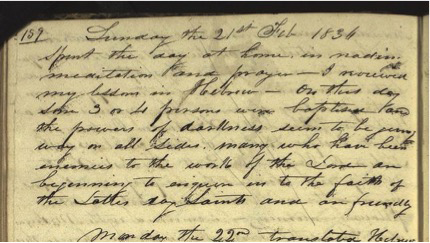The Joseph Smith Papers project is one of the most significant ongoing projects the Church has ever taken on to preserve its history. Find out how historians are making it happen.

Have you ever tried reading old family records? These records can be nearly impossible to read. The ink is faded, the paper is aged and discolored, and even words you recognize have strange spellings and punctuation. This daunting task is exactly the kind of work that the Joseph Smith Papers project team is doing right now.
Often, manuscripts are nearly impossible to read—especially if the author wrote in a hurry. In addition, according to the Joseph Smith Papers team, “even the best writers and spellers left out letters on occasion or formed them imperfectly and incompletely.”
The team explains that they must know the “usual characteristics of each particular writer”—meaning they need to be able to recognize the various unique writing and penmanship styles of the scribes. John Whitmer, for example, almost always left the e off the word “the.” Historians on the Joseph Smith Papers carefully preserve the original spelling, punctuation, paragraph breaks, and even changes in ink color throughout each manuscript they transcribe to give modern readers an authentic experience.
As part of the preparation, each manuscript goes through a rigorous examination process involving multiple historians, several rounds of electronic scanning, comparisons to the originals, exposure to ultraviolet light, and powerful magnification. With these tools, historians can catch details that would otherwise be easily overlooked, such as faded ink and crossed-out words. Several historians repeat these steps for every manuscript, and each copy is compared to the others to make the finished product as complete as possible.
It may be a long and arduous process, but Church historians agree: it is worth every effort to preserve this precious history.
Read the full article about the editorial method of the Joseph Smith Papers project.
Source: The Joseph Smith Papers
—Erin Steenblik Tanner, Mormon Insights
Find more insights
This article is part 2 in a series published in Mormon Insights. Read part 1.
Learn why Church historian Elder Marlin K. Jensen and others believe that The Joseph Smith Papers project is “the most important Church history project of this generation.”
Watch this video to learn more about the Joseph Smith Papers project.



Interesting to gain this insight into the Joseph Smith Papers. I love this project. Thank you for bringing it to our attention!
Wow! I had no idea there was such a huge process in examining all of the original manuscripts. I’m so grateful for the thorough nature of this project.
I once worked on transcribing eighteenth century documents, and it was extremely difficult. Although I’m a novice, it still took me a couple hours to transcribe just one page!